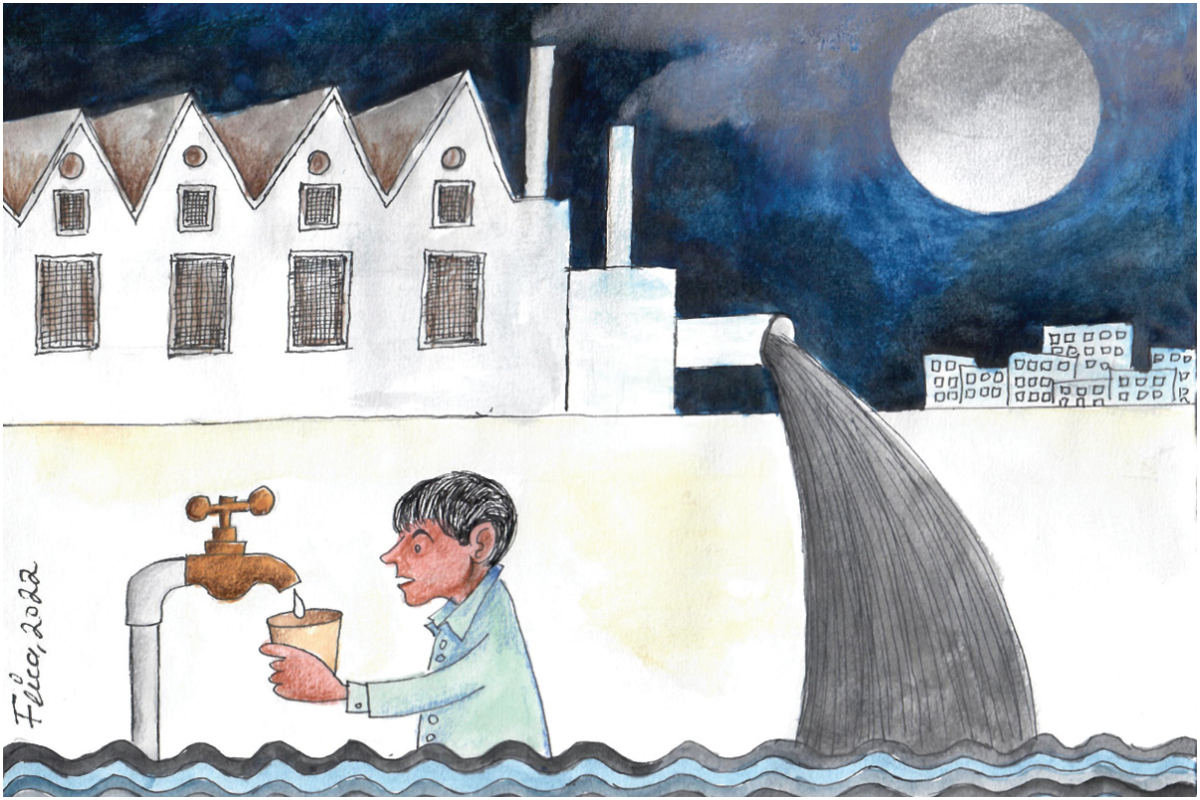
Not a Drop to Drink
Unchecked industrial pollution has rendered the waters of Pakistan’s five rivers dangerous for human and animal consumption and irrigation
Last year, quite a scene was witnessed during a Punjab Assembly session when Hassan Mujtaba, a member from Chiniot district, complained that the discharge from factories in Faisalabad city had degraded the quality of water in the Chenab River to the extent that hundreds of acres of fertile lands in his district had become uncultivable. He had submitted a question in the Assembly secretariat asking the provincial environment minister what policy initiatives and measures the environment department had taken to check the pollution of rivers in the province, but the concerned minister took two-and-a-half-years to answer the question. And then, in his belated reply, the minister shrugged off responsibility, citing helplessness in the matter, and blaming the bureaucracy for non-cooperation.
The lackadaisical response to the Chiniot lawmaker’s query was significant for more than just the specific issue it addressed. It symbolised the general attitude that prevails in the country towards our main water resources, the rivers that are the very lifeline of our existence.
The issue of fertile agricultural lands being rendered infertile by the polluted waters of rivers is not restricted to Chiniot district. The malaise prevails in several other areas of the Punjab province. From its source in Jammu, the Chenab River begins its journey in Pakistan from Sialkot, merging into the Indus River at Punjnad near Muzaffargarh district. Two big cities, Faisalabad and Multan, and several small cities such as Sialkot, Gujrat, Mandi Bahauddin, Sargodha, Chiniot, Jhang etc are situated close to the Chenab. And along the river’s course, more than 50 drains dump untreated sewage and solid waste from these cities and their industrial discharge into the river. One can actually see huge dumps of solid waste from Multan and Jhang polluting the Chenab’s banks. In addition, two other rivers — the Jhelum and Ravi — merge into with it at different points. They also carry water polluted by dozens of cities and towns on their banks, finally unloading all that into the Chenab, and eventually the Indus.
A study evaluating the water quality of Chenab River conducted in 2012-14 (by Firdaus Kausar and others) revealed that downstream of Qadirabad (Mandi Bahauddin district), the quality of the water in the Chenab kept worsening. The study concluded that the river water fell under the ‘marginal’ category for drinking and livestock watering, due to the presence of pollution by the heavy metals in it, which was above safe limits. In 2015, researchers at the Department of Biotechnology, Quaid-e-Azam University, investigated the impact of polluted sediment on plant growth (Brassica napus) and concluded that pollutants dumped into the river were posing more danger to plant life than pollutants on dry land, as sediments in the river absorb pollutants and affect aquatic life. Discussing the sorry situation of the Punjab’s rivers, Tauqeer Ahmed, a senior officer at the Environment Protection Department (EPD), Punjab, confirmed that they are heavily contaminated with persistent organic pollutants that originate from industrial effluents and run-off pesticides.
The story of Chenab River is the same as that of all five rivers in the Punjab, including the Indus, Jhelum, Ravi and Sutlej, which constitute the Indus River basin. The five rivers provide ecosystem services that support the country’s economy, with the canals flowing from these rivers making up the world’s largest contiguous irrigation system. But, like the Chenab, all the rivers flowing through the country’s cities and towns have turned into open drains full of untreated municipal sewage and industrial effluents dumped into them. Pakistan treats only one per cent of its urban wastewater, while the rest goes untreated into the rivers. Yet, about 50 million people live in the Indus Rive system’s basin, including 24 million people in the Punjab’s major cities, including Lahore and Faisalabad, and 70 other smaller cities.
The massive pollution in River Sutlej is another example of the way we are recklessly destroying our water resources. A study by the Environment Protection Agency (EPA), Punjab found that after a drain in the Kaur district has emptied its pollutants into the Sutlej, the value of sulfide in the river exceeds the National Environment Quality Standards (NEQS) limits and the value of Total Suspended Solids (TSS) exceeds the NEQS limits at Head Islam, which is the river’s entry point into Bahawalpur. The Sutlej enters Pakistan in the Kasur district, but its original water source has been sold to India under the Indus Basin Treaty. Now two irrigation link canals, the Bulloki Sulemanki Link Canal and the Pakpattan Islam Link Canal, join the river to augment its flow. Both link canals carry industrial and municipal wastewater to the river from nearby urban and industrial areas, including the Kasur and Pakpattan districts. The effect of the pollution by municipal and industrial discharges in the river becomes hazardous in certain reaches, resulting in the depletion of dissolved oxygen which is necessary for fish life.
In addition to disposal points marked as pumping stations, wastewater-carrying drains discharge effluents into the river randomly. The Pandoki drain in the Kasur district, with an average discharge of 86.95 cusecs, is the main continuous source of the Sutlej’s pollution. The Pandoki drain comes from Raiwind and carries the municipal and industrial waste of Raiwind and Kasur cities, including wastewater from the treatment plants of Kasur tanneries. The industrial effluents contain pollutants including dissolved and suspended organic matter, heavy metals and other toxic chemicals. Harmful industrial chemicals have the potential to pose serious health problems and can negatively impact downstream agriculture. Municipal wastewater from Bahawalnagar, Okara, Bahawalpur and Vehari districts also ends up in the Sutlej. The disposal of untreated sewage laden with a heavy organic load adds to the deoxygenation of the river water. In addition, municipal wastewaters contain pathogenic organisms that contaminate the river water which is used as a source of drinking water downstream. In these agricultural districts fertilisers and pesticides are used excessively; the runoffs from farms are then added to surface and groundwater pollution. During rainfall, in particular, the surface overflows reach the river – carrying large quantities of pollutants. The discharge of excessive quantities of fertilisers may give rise to eutrophication in the receiving water bodies, and concentrations of heavy metals may harm aquatic life. This in turn could affect consumers’ health.
In 2014, the WorldWide Fund for Nature Pakistan (WWF-Pakistan) assessed the situation of the Ravi River near Lahore, mapping major urban drains and industrial discharges, and concluded that the Ravi is Punjab’s most polluted river. With its original water being used by India, the Ravi in Pakistan gets almost all of its water from the Chenab through a canal linking the two. Experts at the Environment Protection Department (EPD) say that the Ravi used to have a rich biodiversity with at least 31 fish species besides other wildlife, but much of this has disappeared because of high degrees of pollution. At present, the river is biologically dead, implying that it lacks dissolved oxygen downstream of Lahore, according to a 2009 report by the EPD. Urban sewage, solid waste, industrial waste water and water containing pesticides from agriculture fields flow into it without treatment.
In the 1960s, when environmental hazards were not the issue of concern the way they are today, industrial centres in Lahore were set up close to the city’s natural drains for rain water (or small river tributaries) so that their wastewater could flow into them and finally fall into the Ravi. This easy solution of disposal played havoc with the Ravi as the government failed to compel the factories to follow regulations and treat water before discharging it into natural drains. In 2017, a team of the Asian Development Bank (ADB), headed by Julian Doczi, prepared a technical assistance report on the Ravi, which concluded that the Punjab lacks the infrastructure to control, capture and treat the discharge of polluted water, and there are no effective policies and regulations in place to reduce the pollution at source. There are some laws which bind industries to release waste water into the river only after treating it, but they are ineffective due to insufficient monitoring and enforcement coupled with technical and capacity constraints.
Despite several studies and warnings, little has been done to redeem the situation. Two different studies proposed installing treatment plants in Lahore to clean up the river, but have been gathering dust. In 2012, a commission set up by the Lahore High Court had recommended a low cost ($500,000) bioremediation plant in Lahore as a first step, but it was not followed through. Instead, the Lahore Development Authority (LDA) proposed a $3 billion waterfront urban development project for the river that could preclude the treatment plant, but that also failed to take off. Five years ago, the ADB proposed providing technical assistance, sponsored by foreign donors to the Punjab government for improving environment management in the Ravi basin, but this offer was also turned down. Such is the state of neglect and indifference to the issue that the Punjab government has not yet framed quality standards for surface water pollution.
At the recent climate conference in Egypt, Pakistan pleaded for international assistance to make up for the losses it incurred due to climate change caused by polluting nations in the world. Pakistan’s case is unarguably justified, but mere international financial assistance cannot be a solution to the environmental issues the country is facing. The reality is that addressing environmental issues has been on the lowest rung of the priority list of all the successive governments in the country, except for that of Prime Minister Imran Khan, who launched a vigorous environmental campaign and took concrete measures in regard to tree plantation all over the country. Pakistan is a water-stressed country. With a galloping rise in its population, the availability of clean or uncontaminated water for irrigation and drinking should be a major concern for the government and society. Ground water in the Punjab is fast depleting. Our failure in conserving and cleaning the surface water resources will put our survival at stake. Biologically dead, highly contaminated rivers such as the Ravi near Lahore or Chenab near Chiniot may spell disaster for our very existence.
Catch all the National Nerve News, Breaking News Event and Latest News Updates on The BOL News
Download The BOL News App to get the Daily News Update & Live News.












 Read the complete story text.
Read the complete story text. Listen to audio of the story.
Listen to audio of the story.